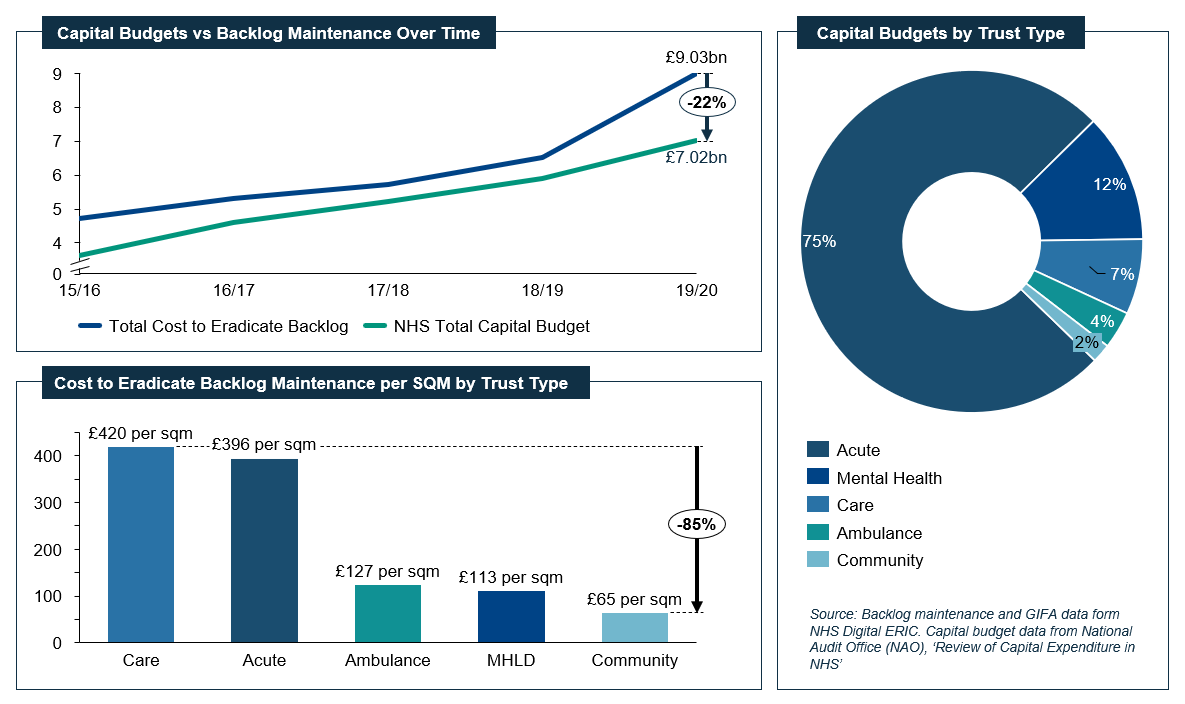Estates and facilities (E&F) management plays a critical role in the delivery of all healthcare services. Every department or location depends on E&F services, with each facing unique challenges. These challenges have been significantly exacerbated by recent events such as the COVID-19 pandemic and Brexit, which have placed even greater pressures on supply chains and staff.
That is why overcoming these challenges and developing robust facilities management (FM) strategies, which ensure spaces are clinically safe, fit for purpose and able to flexibly meet patient demand, is increasingly becoming a key priority for Trusts.
In this article, we will look at the opportunities the shift to an integrated care system (ICS), presents and how your Trust can leverage them.
The key Estates and Facilities challenges Trusts are facing
Before examining the potential of an ICS to transform E&F provision, it is worth taking a closer look at some of the common pressures and challenges that are impacting Trusts across the NHS.
Perhaps most stark, is the current level of backlog maintenance. At the end of the last financial year the total cost to eradicate backlog maintenance stood at more than £9bn. This is around 20% more than the NHS’s entire capital budget of £7bn, with acute settings requiring 85% greater expenditure per square metre than community settings.

Impacting a Trust’s ability to address this issue is a lack of capital and labour. There has been no long-term capital commitment from the government for E&F and there was no reference to the NHS estate in the November spending review, other than what had previously been outlined in the Long-Term Plan (LTP) and Health Infrastructure Plan (HIP). The emphasis remains on ambitious building projects rather than how to meet the maintenance needs.
On the labour side, the sector is struggling with the same supply issues as many others in the wake of COVID-19 and Brexit, making it harder to complete necessary tasks. But failing to maintain E&F correctly, will present risks to patient safety. Indeed, analysis by The King’s Fund suggests more than 5,000 clinical service incidents are caused by E&F failures each year.
Looking ahead, the function and form of E&F is changing. For the past 20 to 30 years estates have been constructed for a particular purpose, but it has become clear flexibility needs to be embedded in the design to allow Healthcare settings to adapt to shifting patient demand. Alongside this, net zero is now a core principle.
Developing an ICS model to address these challenges
Into this mix of challenges, the ICS model brings complexity. Formations of ICS’s as legal entities will become a statutory requirement from the 1st of July 2022 and understanding the different service provisions and settings that come under the umbrella of an ICS, will be critical to successfully adapting to this new landscape.
But with this complexity comes a number of advantages associated with having control over an entire ICS estate, and being able to make decisions that benefit the whole ICS.
Historically speaking, Trusts have arranged the delivery of their E&F services in one of four models, which must be understood in the context of an ICS:
- Bundled services – Several single services contracted directly with the same supplier. One of the benefits here is improving negotiating power and potentially reducing the number of suppliers needed.
- Fully integrated services – A service provider self-delivers all services, with some limited subcontracting. The key benefit is economies of scale and the ability to provide consistent service specifications and performance standards across an entire ICS.
- Agent model – Management functions are carried out by an agent allowing them to focus on cost reduction and management excellence.
- Total property outsourcing – A complete outsourcing of an ICS’s property needs to be done in a consortium of, for example, private sector finance groups.
The first two models are the most common, but the circumstances of individual ICSs will determine which is the most appropriate path to follow. In each case, a joined-up ICS-wide approach will enable Trust’s to seize opportunities that are emerging across hard FM, soft FM and utilities.
For example, the recent increases in virtual care and working will enable an ICS to re-examine their entire portfolio of sites and optimise for the requirements of the future.
There will also be numerous opportunities to create synergies and efficiencies, including:
- Re-distributing service lines according to new organisational, geographic and category types.
- Unifying maintenance contracts across sites.
- Strategic sourcing and economies of scale throughout the supply chain.
- Performance tracking and relationship management.
- Greater career opportunities for the workforce.
Similarly, utilities consumption will be able to be monitored across different settings and supply consolidated where it makes sense to do so. Moreover, the ICS model will also enable larger group purchasing, which will strengthen the ability to weather the significant sector and price instability currently being experienced.
Understanding the opportunities of an ICS
To take the E&F opportunities available to them, Trusts must first be able to identify how effective their current E&F provision is within the context of their ICS.
Akeso & Co’s E&F dashboard has been developed to provide this capability. Its data-driven insights will support Trusts to devise an E&F strategy in several ways, including:
- The ability to focus on key areas of E&F management to provide a clearer view of how each compares to NHS E&F management across England.
- The ability to target analysis of a specific Trust or group level to identify organisations that can provide transformational advice.
- The ability to benchmark within an ICS or on a national level to understand where best performance is and to develop new strategies.
- The ability to filter information and drill down into it to understand a range of cost profiles at different organisational levels and identify opportunities for improvement.
- The capacity to evaluate key metrics to understand potential future regional or organisational challenges.
As the ICS model becomes fully embedded in the NHS, Trusts must actively engage with the potential benefits on offer to realise them.
Tools such as Akeso & Co’s dashboard bring visibility and understanding to the complexities involved, enabling them to identify opportunities and take them.
If you would like a demonstration, please do get in touch with Debora Salvado at debora.salvado@akeso.co.ukdebora.salvado@akeso.co.uk.
